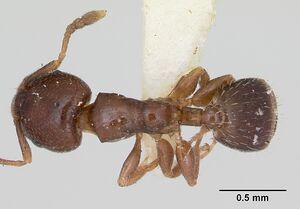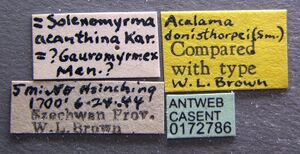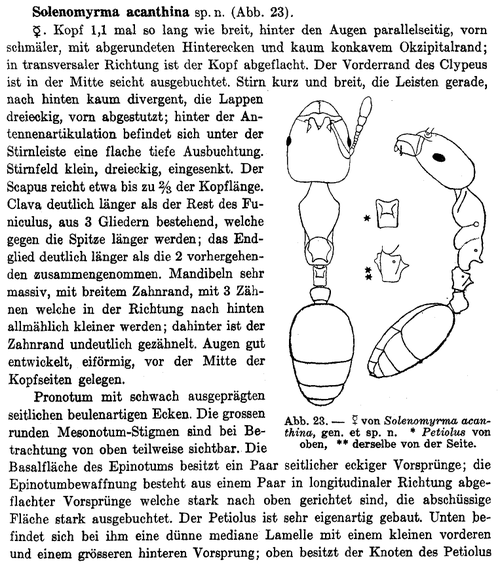Gauromyrmex acanthinus
| Gauromyrmex acanthinus | |
|---|---|

| |
| Scientific classification | |
| Kingdom: | Animalia |
| Phylum: | Arthropoda |
| Class: | Insecta |
| Order: | Hymenoptera |
| Family: | Formicidae |
| Subfamily: | Myrmicinae |
| Tribe: | Crematogastrini |
| Genus: | Gauromyrmex |
| Species: | G. acanthinus |
| Binomial name | |
| Gauromyrmex acanthinus (Karavaiev, 1935) | |
| Synonyms | |
| |
This ant appears to be rather common in India and China, and I believe that I have seen it on several occasions in Bengal Province nesting under loose bark, though the actual specimens were lost in a wartime shipment. In life, the distinctive point of recognition lies in the extremely depressed appearance of the ant, even when moving about. It appears to the naked eye somewhat like a flattened Leptothorax, and its attachment to tree trunks and plant cavities may be correlated with the habitus. (Brown 1953)
Identification
Chen and Chen (2022): This species is easily distinguished from the congeners of this genus by notably dentate shoulder of pronotum.
Gauromyrmex acanthinus is similar to Gauromyrmex bengkalisi, its only congener, but can be separated by the relatively smooth mesopleuron of acanthinus in comparison to the foveolate mesopleuron on bengkalisi.
Keys including this Species
Distribution
Latitudinal Distribution Pattern
Latitudinal Range: 32.0744° to 32.0744°.
| North Temperate |
North Subtropical |
Tropical | South Subtropical |
South Temperate |
- Source: AntMaps
Distribution based on Regional Taxon Lists
Indo-Australian Region: Singapore.
Oriental Region: India, Vietnam (type locality).
Palaearctic Region: China.
Distribution based on AntMaps
Distribution based on AntWeb specimens
Check data from AntWeb
Countries Occupied
| Number of countries occupied by this species based on AntWiki Regional Taxon Lists. In general, fewer countries occupied indicates a narrower range, while more countries indicates a more widespread species. |

|
Estimated Abundance
| Relative abundance based on number of AntMaps records per species (this species within the purple bar). Fewer records (to the left) indicates a less abundant/encountered species while more records (to the right) indicates more abundant/encountered species. |

|
Biology
Smith (1948), included this information about a collection that was sent and described to him by Bill Brown: Szechwan Province, China; 5 miles north Hsin Ching, 1700 ft., 6-24-44, from trunk and roots of Fiecus sp., Schwangliu, 6-21-44, from a moist, moss-covered bank deeply shaded by bamboo. These specimens were collected by Wm. L. Brown, Jr., who is of the opinion that the ants may nest in the soil. He (Brown) noted that those from the first-mentioned locality were timid and stuck tenaciously to the bark when an attempt was made to collect them. Those from the other locality, however, were rather quick in their pace.
Castes
  
| |
| . | Owned by Museum of Comparative Zoology. |
Images from AntWeb
   
| |
| Worker. Specimen code casent0172782. Photographer April Nobile, uploaded by California Academy of Sciences. | Owned by MCZ, Cambridge, MA, USA. |
   
| |
| Paratype of Gauromyrmex acanthinus. Worker. Specimen code casent0172784. Photographer April Nobile, uploaded by California Academy of Sciences. | Owned by MCZ, Cambridge, MA, USA. |
   
| |
| Paratype of Gauromyrmex acanthinus. Worker. Specimen code casent0172785. Photographer April Nobile, uploaded by California Academy of Sciences. | Owned by MCZ, Cambridge, MA, USA. |
   
| |
| Worker. Specimen code casent0172786. Photographer April Nobile, uploaded by California Academy of Sciences. | Owned by MCZ, Cambridge, MA, USA. |
   
| |
| Worker. Specimen code casent0172787. Photographer April Nobile, uploaded by California Academy of Sciences. | Owned by MCZ, Cambridge, MA, USA. |
   
| |
| Worker. Specimen code casent0172788. Photographer April Nobile, uploaded by California Academy of Sciences. | Owned by MCZ, Cambridge, MA, USA. |
   
| |
| Worker. Specimen code casent0172789. Photographer April Nobile, uploaded by California Academy of Sciences. | Owned by MCZ, Cambridge, MA, USA. |
   
| |
| Specimen code sam-ent-011510a. . | |
Nomenclature
The following information is derived from Barry Bolton's Online Catalogue of the Ants of the World.
- acanthinus. Solenomyrma acanthina Karavaiev, 1935a: 103, fig. 23 (w.) VIETNAM.
- Type-material: 2 syntype workers.
- Type-localities: 1 worker Vietnam (“Central Annam”): Bana, nr Tourane, 1400 m., 1.x.1931, no. 5768 (K. Davydov), 1 worker Vietnam (“Central Annam”): Col de Nuage, ix.1931, no. 5769 (K. Davydov).
- Type-depository: SIZK.
- Combination in Vollenhovia: Bolton, 1995b: 422;
- combination in Gauromyrmex: Brown, 1953c: 10; Bolton, 2003: 269.
- Status as species: Chapman & Capco, 1951: 161; Wu, J. & Wang, 1995: 87; Bolton, 1995b: 422; Lin & Wu, 2003: 64; Terayama, 2009: 147; Guénard & Dunn, 2012: 43; Bharti, Guénard, et al. 2016: 37.
- Senior synonym of donisthorpei: Brown, 1953c: 10; Bolton, 1995b: 422.
- Distribution: China, India, Taiwan, Vietnam.
- donisthorpei. Acalama donisthorpei Smith, M.R. 1949a: 207, figs. 1, 2 (w.) INDIA (Sikkim).
- Type-material: holotype worker, 21 paratype workers.
- Type-locality: India: Prov. Assam, Sikkim.
- [Note: specimens intercepted on orchid in plant quarantine, Hawaii: Honolulu, 14.iv.1947 (T.F. Chong).]
- Type-depository: USNM.
- Junior synonym of acanthinus: Brown, 1953c: 10; Bolton, 1995b: 422.
Unless otherwise noted the text for the remainder of this section is reported from the publication that includes the original description.
Description
Worker
Chen and Chen (2022):
Head: Head in full-face view slightly longer than broad, posterior margin weakly concave; eyes median size and weakly convex, located in front of midpoint of lateral margin of head; frontal carina and antennal scrobes absent; mandibles triangular, masticatory margin with 6 teeth, with a large apical tooth, followed by a smaller preapical tooth and 4 denticles; anteromedian margin of clypeus concave, with lateral part forming a pair of weak lobes.
Mesosoma: Promesonotal dorsum in lateral view convex and higher than metanotum; promesonotal suture absent; metanotal groove concave; propodeum dorsum convex and gradual decline posteriorly, posterodorsal corner with a triangular tooth; propodeal lobes with a blunt posterior margin. In dorsal view, humeral corners of pronotum with a pair of distinct teeth; lateral sides of pronotum almost straight and convergent posteriorly; posterodorsal corner of pronotum with a pair of blunt processes, and not passing smoothly to lateral margins of mesonotum; promesonotal suture absent, but sometimes with a faint trace (Figs. 2, 5, 8); anterior margin of mesonotum convex, lateral margin weakly convex and convergent posteriorly; metanotal groove depressed, and strongly constricted between mesonotum and propodeum; lateral margin of propodeum convex, posterior margin concave, posterolateral corner forming a pair of blunt teeth.
Waist: Anterodorsal corner of petiole forming a small tooth which points forward and upwards; dorsum with a thick tooth slightly curving backwards; subpetiolar process triangular transparently; in dorsal view, petiole rectangular, blunt denticle in anteriolateral corner, with a transverse ridge in middle. Postpetiole in lateral view smaller than petiole, dorsal margin strong convex, sternite of postpetiole much smaller than its stergite, anteroventral corner with an obtuse angle; in dorsal view anterolateral corner of postpetiole rounded, lateral margin almost straight and weakly convergent posteriorly. Gaster: Gaster in lateral view oval, in dorsal view humeral corner of gaster obtuse-angulate.
Sculpture: Mandibles scattered with piligerous punctures; frontal lobes with longitudinal stria, which sometimes extending backward to a half of head; cheek with longitudinal stria; the rest of the head smooth and shiny, except scattered with piligerous punctures; middle part of mesonotum and propodeum smooth and shiny, but with their lateral parts rugulose; face of metanotal groove scattered with ridges; lateral face of pronotum and upper part of propodeum smooth and shiny, lower part of propodeum reticulate-rugulose; gaster smooth and shiny. Pilosity: Body with dense erect hairs and sparse pubescence, antennae with abundant pubescence. Color: Body yellow to yellow-brown.
Measurements (n - 7): TL 2.4–2.7, HL 0.57–0.66, HW 0.53–0.63, CI 91–100, SL 0.36–0.38, SI 60–64, ED 0.12–0.14, PW 0.34–0.41, MSL 0.61–0.75, PL 0.17–0.20, PH 0.13–0.16, DPW 0.12–0.15, LPI 72–89, DPI 72–79.
References
- Bolton, B. 1995b. A new general catalogue of the ants of the world. Cambridge, Mass.: Harvard University Press, 504 pp. (page 422, combination in Vollenhovia)
- Bolton, B. 2003. Synopsis and Classification of Formicidae. Mem. Am. Entomol. Inst. 71: 370pp (page 269, Combination revived in Gauromyrmex)
- Brown, W. L., Jr. 1953c. Characters and synonymies among the genera of ants. Part I. Breviora 11: 1-13 (page 10, combination in Gauromyrmex)
- Jaitrong, W., Jeenthong, T. 2014. New record of Gauromyrmex acanthinus (Hymenoptera: Formicidae) from Thailand. The Thailand Natural History Museum Journal 8(1): 13-18.
- Karavaiev, V. 1935a. Neue Ameisen aus dem Indo-Australischen Gebiet, nebst Revision einiger Formen. Treubia 15: 57-118 (page 103, fig. 23 worker described)
- Khachonpisitsak, S., Yamane, S., Sriwichai, P., Jaitrong, W. 2020. An updated checklist of the ants of Thailand (Hymenoptera, Formicidae). ZooKeys 998, 1–182 (doi:10.3897/zookeys.998.54902).
- Liu, C., Fischer, G., Hita Garcia, F., Yamane, S., Liu, Q., Peng, Y.Q., Economo, E.P., Guénard, B., Pierce, N.E. 2020. Ants of the Hengduan Mountains: a new altitudinal survey and updated checklist for Yunnan Province highlight an understudied insect biodiversity hotspot. ZooKeys 978, 1–171 (doi:10.3897/zookeys.978.55767).
- Radchenko, A.G., Fisher, B.L., Esteves, F.A., Martynova, E.V., Bazhenova, T.N., Lasarenko, S.N. 2023. Ant type specimens (Hymenoptera, Formicidae) in the collection of Volodymyr Opanasovych Karawajew. Communication 1. Dorylinae, Poneromorpha and Pseudomyrmecinae. Zootaxa, 5244(1), 1–32 (doi:10.11646/zootaxa.5244.1.1).
- Wang, W.Y., Soh, E.J.Y., Yong, G.W.J., Wong, M.K.L., Benoit Guénard, Economo, E.P., Yamane, S. 2022. Remarkable diversity in a little red dot: a comprehensive checklist of known ant species in Singapore (Hymenoptera: Formicidae) with notes on ecology and taxonomy. Asian Myrmecology 15: e015006 (doi:10.20362/am.015006).
References based on Global Ant Biodiversity Informatics
- Chapman, J. W., and Capco, S. R. 1951. Check list of the ants (Hymenoptera: Formicidae) of Asia. Monogr. Inst. Sci. Technol. Manila 1: 1-327
- Cheng D., Z. Chen, and S. Zhou. 2015. An analysis on the ant fauna of Jinzhongshan Nature Reserve in Gunagxi, China. Journal of Guangxi Normal University: Natural Science Edition 33(3): 129.137.
- Eguchi K.; Bui T. V.; Yamane S. 2011. Generic synopsis of the Formicidae of Vietnam (Insecta: Hymenoptera), part I Myrmicinae and Pseudomyrmecinae. Zootaxa 2878: 1-61.
- General D. M., and G. D. Alpert. 2012. A synoptic review of the ant genera (Hymenoptera, Formicidae) of the Philippines. Zookeys 200: 1-111.
- Guénard B., and R. R. Dunn. 2012. A checklist of the ants of China. Zootaxa 3558: 1-77.
- Jaitrong W., and T. Jeenthong. 2015. New record of Gauromyrmex acanthinus (Hymenoptera: Formicidae) from Thailand. The Thailand Natural History Museum Journal 8(1): 13-18.
- Karavaiev V. 1935. Neue Ameisen aus dem Indo-Australischen Gebiet, nebst Revision einiger Formen. Treubia 15: 57-118.
- Li Z.h. 2006. List of Chinese Insects. Volume 4. Sun Yat-sen University Press
- Liu X. 2012. Taxonomy, diversity and spatial distribution characters of the ant family Formicidae (Insecta: Hymenoptera) in southeastern Tibet. PhD Thesis 139 pages
- Terayama M. 2009. A synopsis of the family Formicidae of Taiwan (Insecta: Hymenoptera). Research Bulletin of Kanto Gakuen University. Liberal Arts 17:81-266.
- Terayama Mamoru. 2009. A synopsis of the family Formicidae of Taiwan (Insecta, Hymenoptera). The Research Bulletin of Kanto Gakuen University 17: 81-266.
- Terayama, M. 2009. A synopsis of the family Formicidae of Taiwan (Insecta; Hymenoptera). The Research Bulletin of Kanto Gakuen University 17: 81-266.
- Wu J. and Wang C.. 1995. The ants of China. China Forestry Publishing House, Beijing. 214 pp.




